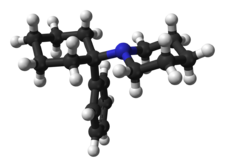Our website is made possible by displaying online advertisements to our visitors.
Please consider supporting us by disabling your ad blocker.
Phencyclidine
 | |
 | |
| Clinical data | |
|---|---|
| Trade names | Sernyl, Sernylan (both discontinued) |
| Other names | CI-395; Phenylcyclohexylpiperidine; "Angel dust"[1] |
| AHFS/Drugs.com | phencyclidine |
| Dependence liability | Physical: Low Psychological: Moderate[2] |
| Addiction liability | Variable, reported from low to high[3][4] |
| Drug class | NMDA receptor antagonists; General anesthetics; Dissociative hallucinogens[5] |
| ATC code |
|
| Legal status | |
| Legal status |
|
| Pharmacokinetic data | |
| Metabolism | Oxidative hydroxylation in liver by CYP450 enzymes, glucuronidation |
| Metabolites | PCHP, PPC, PCAA |
| Onset of action | 2–60 min[6] |
| Elimination half-life | 7–46 hours |
| Duration of action | 6–48 hours[6] |
| Excretion | Urine |
| Identifiers | |
| |
| CAS Number | |
| PubChem CID | |
| IUPHAR/BPS | |
| DrugBank | |
| ChemSpider | |
| UNII | |
| KEGG | |
| ChEBI | |
| ChEMBL | |
| CompTox Dashboard (EPA) | |
| ECHA InfoCard | 100.150.427 |
| Chemical and physical data | |
| Formula | C17H25N |
| Molar mass | 243.394 g·mol−1 |
| 3D model (JSmol) | |
| Melting point | 46.5 °C (115.7 °F) |
| Boiling point | 136 °C (277 °F) |
| |
| |
| Data page | |
| Phencyclidine (data page) | |
| | |
Phencyclidine or phenylcyclohexyl piperidine (PCP), also known in its use as a street drug as angel dust among other names, is a dissociative anesthetic mainly used recreationally for its significant mind-altering effects.[1][5] PCP may cause hallucinations, distorted perceptions of sounds, and violent behavior.[5][8][9] As a recreational drug, it is typically smoked, but may be taken by mouth, snorted, or injected.[5][7][8] It may also be mixed with cannabis or tobacco.[1][5]
Adverse effects may include seizures, coma, addiction, and an increased risk of suicide.[8] Flashbacks may occur despite stopping usage.[9] Chemically, PCP is a member of the arylcyclohexylamine class, and pharmacologically, it is a dissociative anesthetic.[5][10][11] PCP works primarily as an NMDA receptor antagonist.[10]
PCP is most commonly used in the United States.[12] While usage peaked in the US in the 1970s,[13] between 2005 and 2011 an increase in visits to emergency departments as a result of the drug occurred.[8] As of 2017 in the United States, about 1% of people in 12th grade reported using PCP in the prior year while 2.9% of those over the age of 25 reported using it at some point in their lives.[14]
- ^ a b c "PCP Fast Facts". National Drug Intelligence Center. 2003. Archived from the original on 14 August 2021. Retrieved 19 February 2018.
- ^ Stobo JD, Traill TA, Hellmann DB, Ladenson PW, Petty BG (1996). The Principles and Practice of Medicine. McGraw Hill Professional. p. 933. ISBN 9780071383653.
high abuse liability
- ^ Cite error: The named reference
NHM-PCP and ketaminewas invoked but never defined (see the help page). - ^ Stobo JD, Traill TA, Hellmann DB, Ladenson PW, Petty BG (1996). The Principles and Practice of Medicine. McGraw Hill Professional. p. 933. ISBN 9780071383653.
high abuse liability
- ^ a b c d e f g Giannini AJ (1998). "Chapter 35: Phencyclidine". In Tarter RE, Ammerman R, Ott PJ (eds.). Handbook of Substance Abuse: Neurobehavioral Pharmacology. New York: Plenum Publishing Corporation. pp. 579–587. ISBN 978-1-4757-2913-9.
- ^ a b Riviello RJ (2010). Manual of forensic emergency medicine : a guide for clinicians. Sudbury, Mass.: Jones and Bartlett Publishers. pp. 41–42. ISBN 9780763744625.
- ^ a b "NIDA InfoFacts: Hallucinogens – LSD, Peyote, Psilocybin, and PCP". National Institute on Drug Abuse. Retrieved 2018-02-19.
- ^ a b c d Bush DM (2013). "Emergency Department Visits Involving Phencyclidine (PCP)". The CBHSQ Report. Rockville (MD): Substance Abuse and Mental Health Services Administration (US). PMID 27656747.
PCP can lead to hostile behavior that may result in episodes of extreme violence
- ^ a b "Hallucinogens". National Institute on Drug Abuse. January 2016. Retrieved 20 February 2018.
- ^ a b Marion NE, Oliver WM (2014). Drugs in American Society: An Encyclopedia of History, Politics, Culture, and the Law [3 volumes]. ABC-CLIO. p. 732. ISBN 9781610695961.
- ^ Zedeck BE, Zedeck MS (2007). Forensic Pharmacology. Infobase Publishing. p. 97. ISBN 9781438103822.
- ^ "GINAD". www.ginad.org. Archived from the original on 2018-09-10. Retrieved 2018-02-20.
- ^ "PCP". CESAR. Archived from the original on 12 March 2010. Retrieved 20 February 2018.
- ^ "Hallucinogens". NIAD. Archived from the original on 3 June 2020. Retrieved 20 February 2018.
Previous Page Next Page


